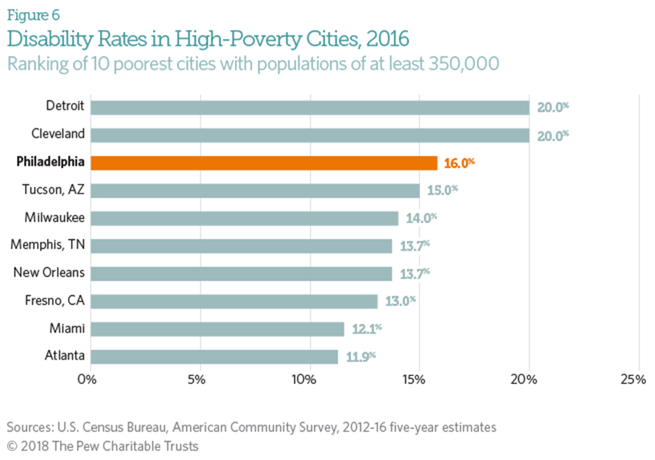
July 17, 2018
Philadelphia residents have the highest rate of physical, emotional and cognitive disabilities among large U.S. cities, a statistic that appears to reflect the deeper degree of poverty found in cities near the top of the list, according to new research from the Pew Charitable Trusts.
Data from the U.S. Census Bureau's 2016 American Community Survey found that 16 percent of Philadelphians, or about 246,000 people, suffered from some form of disability that year.
A disability is defined by the Census Bureau as “a long-lasting physical, mental, or emotional condition that can make it difficult for a person to do activities such as walking, climbing stairs, dressing, bathing, learning, or remembering; it can also impede a person from being able to go outside the home alone or to work at a job.”
Philadelphia was 3.5 percentage points above the national average and at least five percentage points ahead of several other major cities, including New York, Chicago and Los Angeles.
Disability rate among largest U.S. cities in 2016.
A further breakdown of census data determined that Philadelphia led the nation in cognitive disabilities (7.7 percent) and ambulatory difficulty (9.6 percent).
Among U.S. cities with the highest poverty rates, Philadelphia was third behind Detroit and Cleveland in the prevalence of disabilities in 2016. Pew researchers found a strong correlation between between poverty and disability, citing a previous Cornell University study that determined nearly a third of working age adults with a disability live below the poverty line.
Disability rate among most impoverished U.S. cities in 2016.
The costs of disability ultimately return to the city in the form of demand for social services, which have become a growing area of focus for Mayor Jim Kenney and the city's newly formed Office for People With Disabilities.
In addition to housing modifications, nursing care and employment services, Philadelphia currently provides varying levels of care to thousands of residents, with funding provided by state and federal appropriations.
Follow Michael & PhillyVoice on Twitter: @MTanen88 | @thePhillyVoice
Like us on Facebook: PhillyVoice
Add Michael's RSS feed to your feed reader
Have a news tip? Let us know.
 Source/Pew Charitable Trusts
Source/Pew Charitable Trusts Source/Pew Charitable Trusts
Source/Pew Charitable Trusts